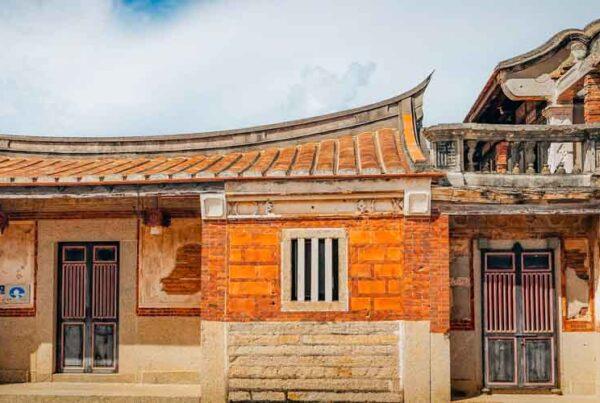Encounter History in the Modern Era
TEXT & PHOTOS / PENGHU COUNTY GOVERNMENT
***
Penghu has had an important position on sea navigation routes since ancient times. Landings by the Dutch, French, Japanese, and Chinese in succession and the mix of these four influences bestowed the Penghu archipelago its rich history and culture. Among the historic sites on the islands are exotic-feel Yuweng Island Lighthouse, a mysterious ammunition depot with copper-lined walls, the pure white Xiyu Dongtai Fort, the lofty Xiyu Xitai Fort, the monuments to fallen generals looking out over the sea on Shetou Mountain, the tomb of French admiral Anatole-Amédée-Prosper Courbet hidden in the city, and Magong City’s Old Street. In all these places the beauty and sadness of the Penghu archipelago can be experienced.

Penghu is famed for its sea, with azure being the color synonymous with the islands in many people’s eyes. However, apart from sky blue, it also has colors of a mottled past. Very different to the sea and sky, there is the color left behind over 1,000 years of history. Every brick on the city walls of old Magong has this color; from Shuncheng Gate, Tianhou Temple, Zhongyang Old Street, and Shigong Temple to Four-eyed Well, Chenghuang Temple, Jinguitou Fort Cultural Park, and Duxingshi Village, All over the island’s you can see how Penghu has moved slowly forward from imperial to modern times.

Tianhou Temple
Penghu’s Tianhou Temple is the oldest Mazu temple in all of Taiwan. Located on Zhongyang Old Street in central Magong, this is a must-go spot for visitors to Penghu. It is said that the temple existed prior to 1604. Its main architectural feature is the use of local coral stone to build the outer walls. Precious cultural relics are housed within, such as ornate golden-powder paintings and the Gong Pi Si Wen (Blessings upon all Intellectuals) plaque. The temple was made a national historic site in 1983.


Shuncheng Gate
Shuncheng Gate was the “Little West Gate” of Magong’s walled city built after the Sino-French War in 1886. On top of the gate is a plain and modest watch platform; and there is a horse track beside the gate. The wall was built using local basalt and there are battlements made from coral stone on top. Magong Harbor can be viewed from atop the wall. At the side is Duxingshi Village Cultural Park which has attracted many visitors in recent years.

Zhongyang Old Street
Zhongyang Old Street, called “Big Well Street” during the Qing Dynasty, was at the center of Penghu’s commercial activities at the time. After the government established the “Zhongyang Street Historic Site Preservation Area” in 1984 and the street became tourism oriented. Today, the Old Street is home to various guesthouses, coffee shops, and handicraft stores. Many classic souvenirs of Penghu can be found here. Visitors soak up the old-time atmosphere of the lanes and alley all year round.

Chenghuang Temple
Located in downtown Magong, Magong Chenghuang Temple is a national historic site. Enshrined within is Chenghuang Ye (the City God). It is a classic example of Taiwanese temple culture. When the Sino-French War affected Penghu in 1885, it was said that the deity appeared to protect the people; Chenghuang Temple and Tianhou Temple were later awarded plaques by the emperor, the former bearing the words Ling Ying Hou (“God Who Will Show its Spirit to Answer You”). The temple is surrounded by eateries serving locals dishes. After enjoying good food, be sure to visit the temple and see the characteristics of an old Penghu temple.

Tomb of Admiral Anatole-Amédée-Prosper Courbet
French forces landed at Shili 135 years ago and, led by Admiral Anatole-Amédée-Prosper Courbet, occupied Magong in only three days. Highly ambitious, Courbet intended to use Penghu as the base for controlling sea power in East Asia, however, he died of cholera unexpectedly three months later. If you have free time, why not visit the tomb of the French admiral in Magong next to Zhongzheng Elementary School and see the traces of history left behind.
Away from the old city area, Penghu has many more mysterious stories to offer. Apart from the Qing Dynasty, the Japanese, French and Dutch successively left their own legends on the islands. The biggest impacts came from the Ming-Dutch War, the Ming-Qing War, the Sino-French War, and the First Sino-Japanese War. Crushed by the wheel of history and scorched by the flames of war, the Penghu archipelago gained its own distinctive look, with various historic sites, full of stories and bearing memories of time past, that have witnessed the islands’ transformation.

Xiyu Dongtai Fort
Xiyu Dongtai Fort is an old pure white fort on a cape at the southeastern tip of Nei’an Village in Xiyu Township. In contrast to Xiyu Xitai Fort, few visitors come here, making the fort suited to people who like to explore in seclusion. Xiyu Dongtai Fort was once used to defend the Penghu Inner Bay together with Xiyu Xitai Fort, Fengguiwei Fort, Sijiaoyu Fort, and Magong Jinguitou Fort and has been important for the defense of the sea area of the southwest side of Penghu Island since the Ming-Zheng era.


Xiyu Xitai Fort
Xiyu Xitai Fort is located at a high point close to the sea between Nei’an and Wai’an villages. Since the Ming-Zheng era, together with Xiyu Dongtai Fort, Xiyu Xitai Fort was used to defend the sea area of the west and southwest sides of Penghu Island. It was still important for the defense of Penghu Island until the end of the Pacific War in the Japanese Colonial Era. The four characters “Xi Yu Xi Tai” on the wall were written by Qing Dynasty governor of Taiwan Liu Ming-chuan. The fort is one of the most popular attractions of Xiyu.

Ammunition Depot
The ammunition depot with copper-lined walls was constructed in caves during the Japanese colonial era. The walls were lined with copper plate to maintain constant temperature and humidity inside. The decoration is extremely ornate and has a stunning effect. The depot is currently being renovated by the Penghu County Government and it is expected to open to the public in 2020, with admission on an advance application basis.

Yuweng Island Lighthouse
Yuweng Island Lighthouse, also called Xiyu Lighthouse, is located in Wai’an Village in Xiyu Township. It has for a long time guided ships sailing between Xiamen and Taiwan. It was the first lighthouse in the Taiwan/Penghu. The flat and spacious grassy area next to the cliff on the cape to the north of the lighthouse is the best place to view the sunset at Xiyu Lighthouse.
In 1874, British engineer David M. Henderson designed this Western-style lighthouse and a British lighthouse keeper was employed to man it. The grave of the lighthouse keeper’s daughter can still be seen on the west side of the lighthouse outer wall next to the cape with a cross-shaped gravestone and the name Nelly O’Driscoll carved on it.

For more information visit the Penghu Travel Website.













